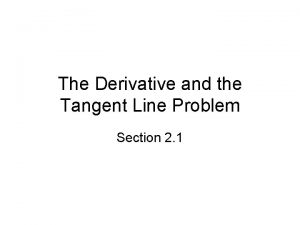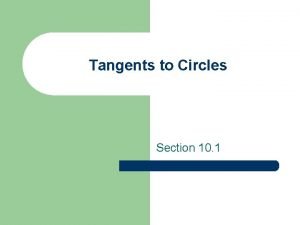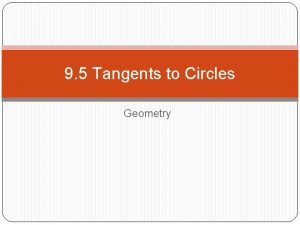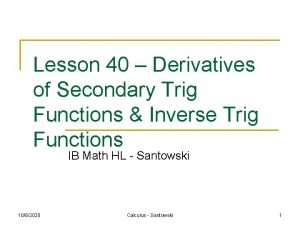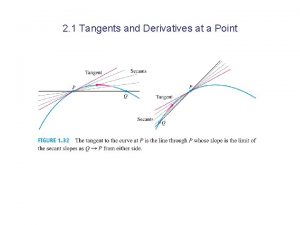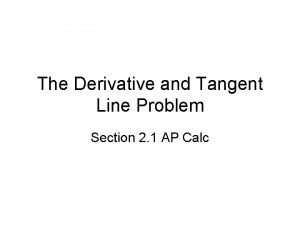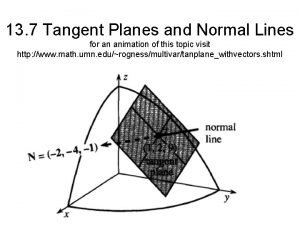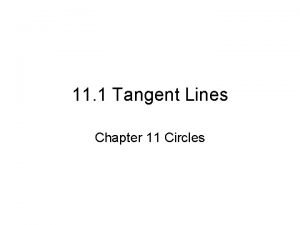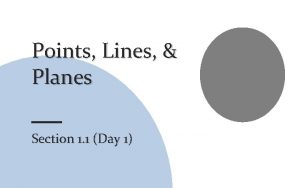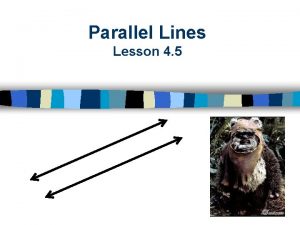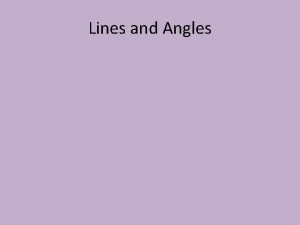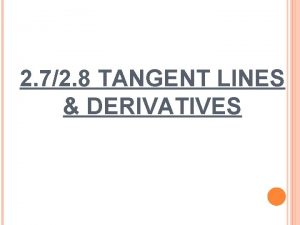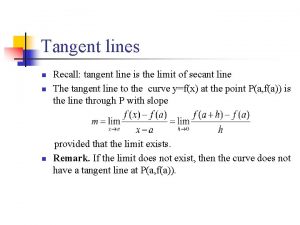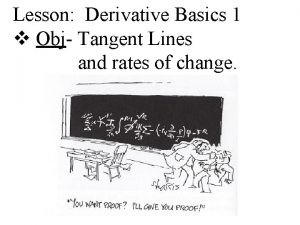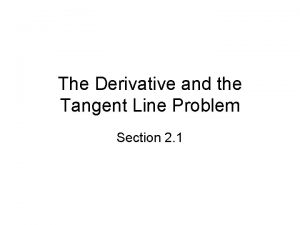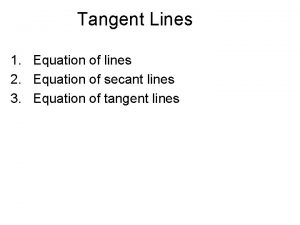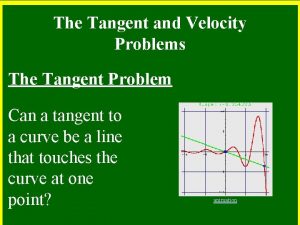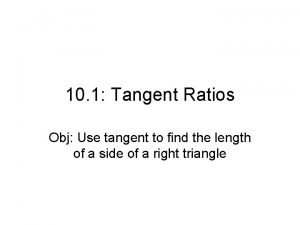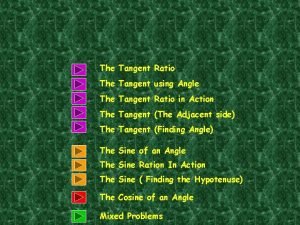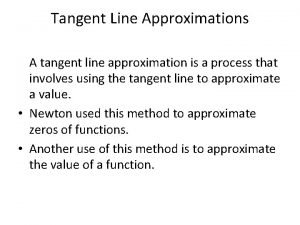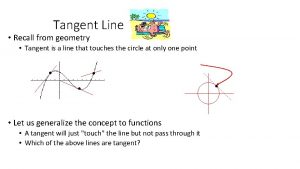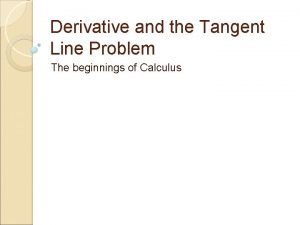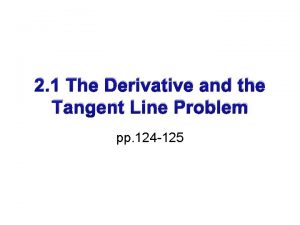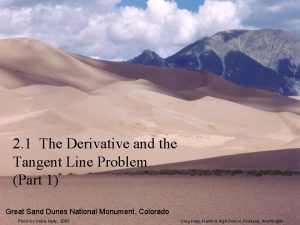Section 2 1 The Derivative Tangent Lines and












































- Slides: 44

Section 2. 1 The Derivative: “Tangent Lines and Rates of Change”

All graphics are attributed to: � Calculus, 10/E by Howard Anton, Irl Bivens, and Stephen Davis Copyright © 2009 by John Wiley & Sons, Inc. All rights reserved.

Introduction � Many real-world phenomena involve changing quantities-the speed of a rocket, the inflation of money (currency), the number of bacteria in a culture, the voltage of an electrical signal, etc. � A “derivative” is the mathematical tool for studying the rate at which one value changes relative to another. � Tangent lines relate this change to slope.

Secant Line vs. Tangent Line � As points P and Q on this graph get closer and closer together, the slope of the secant line through P and Q gets closer to the slope of the tangent line which is only at P. � From Geometry, a secant line crosses twice and a tangent line touches once.

Slope of the Secant Line � The slope of the secant line comes from Algebra I, m = rise/run = � This book uses different notation, but it means the same thing.

Slope of the Tangent Line � The slope of the tangent line is only through one point so we cannot use the same equation. Instead, we must calculate the limit as point Q approaches point P.

Velocity � One of the important themes in calculus is the study of motion. To describe motion we discuss speed and direction of travel which, together, comprise velocity. � For this section, we will only consider motion along a line (rectilinear motion).

Average Velocity Example

Instantaneous Velocity � Instead of an average, we often want to determine velocity at a specific instant in time. It is like finding the slope of the tangent line vs. finding the slope of the secant line. � We only have one time, so we cannot subtract. Instead, we must find the limit as we get closer and closer to the exact time we are looking for.

The Derivative Function � Derivatives are the primary mathematical tool that we use to study and calculate rates of change in a variety of different applications and can be used to calculate instantaneous rates of change.

Representations There are several different formulas you can use which all look different and mean the same thing. Pick the one that you like best and stick with it. � This is the one we used last time: › Derivative = � � Another option:

Example

Slope of the tangent line � You got the same result using any method for the derivative which is the slope of the tangent line for any value of x. � We can use it to find the slope at any given value of x:

Equation for the Tangent Line � This looks intimidating, but it just means to use point slope form once you have the slope.

Previous example continued

Differentiability � It is possible that the limit that defines the derivative of a function may not exist at certain points in the domain of the function. When that happens, the derivative is undefined.

Differentiability Geometrically � Two common ways in which a function that is continuous can fail to be differentiable at certain values of x are when the following exist: › Corner points › Points of vertical tangency

Corner Points � As you can see in the picture, the one sided limits of the slope of the secant line from the two sides of x 0 are not equal so the two sided limit does not exist.

Points of Vertical Tangency � As you can see in the picture, the limits of the slope of the secant line approach +/- infinity which is not a measurable slope.

Points of Discontinuity The previous two slides show that functions can be continuous at certain points where they are not differentiable (meaning you cannot take the derivative there). � It is also true that: � � The proof is interesting, read about it and some related history on page 149.

Other Derivative Notations � We will talk more about these, but you should know that these mean the same thing: � Also, there are other formulas that some people use to find the derivative: � I tend to like the last one, but make your own choice.

The Derivative of a Constant � If you consider the graph of y=2 (for example), or y = any constant, it is a horizontal line whose slope is zero (see graph page 155 if you have a question). � Since the derivative of y=2 equals its slope, the derivative must be 0. � y’ = f’(x) = 0

Derivatives of Power Functions � We have taken the derivative of linear (x 1), quadratic (x 2), and cubic (x 3) functions in previous sections and talked about the “shortcut rule” or power rule. � There is a more formal proof in the middle of page 156.

Derivatives of Sums and Differences � We can use a proof very similar to the on the previous slide (see page 158) to find the derivatives of sums and differences. � Which just means that the derivative of a sum/difference equals the sum/difference of the derivatives (as it did with limits).

Higher Derivatives � The second derivative is the derivative of the first derivative and all of the same rules apply. � As long as we have differentiability, we can continue the process of differentiating to obtain third, fourth, fifth, and higher derivatives of a given function.

Product Rule � We will learn a method for differentiating (taking the derivative of) products. � NOTE: The derivative of the product is NOT equal to the product of the derivatives. An example on the next page will show why.

Counter example � If we say that f(x) = x and g(x) = x 2 and we take their derivatives, we get that f’(x) = 1 and g’(x) = 2 x by using the power rule on each function. � We would like to think that › [f(x) * g(x)]’ = f’(x) * g’(x)] WRONG › = 1 * 2 x = 2 x WRONG � It does not because f(x) * g(x) = x* x 2 = x 3 which has a derivative of f’(x) = 3 x 2 , NOT 2 x.

The Product Rule

Proof

Shorter version of the Product Rule � Since addition is “commutative”, it does not matter what order you add in and 3+7 = 7+3. � When we get to the quotient rule, it has subtraction in it and subtraction is not commutative. � Therefore, I highly suggest you use the product rule in this form: › (f*g)’ = f’*g +g’ *f

Quotient Rule � Everything I wrote about where the product rule comes from and why also applies to the quotient rule.

Quotient Rule cont. � The proof is on pages 165 -166. � The notation I like to use is: � (f/g)’ = f’g - g’f g 2

Rules Summary

Derivatives of sin x, cos x, tan x � You can prove the derivatives of cos x and tan x similarly to the proof for sin x on the following slide.

Proof

Derivatives of csc x, sec x, cot x

Example

Derivatives of Compositions � The “Chain Rule” is the method we use when taking the derivative of a composition of functions f(g(x)). � y’ = dy/dx is obtained by a two-link “chain” of simpler derivatives

Example using � We will use an alternative version of the chain rule on a later slide to find the same derivative. Decide which method you prefer.

Alternative Version of the Chain Rule � can be frustrating during longer problems due to too many variables so you may want to use this instead. � They mean the same thing:

Example #1 using Alternative

Chain Rule with Multiple Interior Functions � Make sure you only do one step at a time.

Encinitas Sunset

World Championships Paris, France 1987 � If you go to You. Tube and search Cruzers baton 1987, you should be able to find my team’s video from the world championships in Paris if you are interested. I am the really tall and white person towards the right. It looks like this:
 Tangent line formula
Tangent line formula Internal tangent vs external tangent
Internal tangent vs external tangent Secants tangents and angle measures
Secants tangents and angle measures Common internal tangent
Common internal tangent Derivative of tan inverse x
Derivative of tan inverse x Derivatives of arc functions
Derivatives of arc functions Example of derivative
Example of derivative Derivative of tangent
Derivative of tangent Tangent planes and normal lines
Tangent planes and normal lines Chapter 11 circles
Chapter 11 circles Find the value of
Find the value of Points lines planes worksheet
Points lines planes worksheet Parallel lines lesson
Parallel lines lesson Short break line drawing
Short break line drawing Parallel lines def
Parallel lines def Hình ảnh bộ gõ cơ thể búng tay
Hình ảnh bộ gõ cơ thể búng tay Ng-html
Ng-html Bổ thể
Bổ thể Tỉ lệ cơ thể trẻ em
Tỉ lệ cơ thể trẻ em Chó sói
Chó sói Glasgow thang điểm
Glasgow thang điểm Hát lên người ơi
Hát lên người ơi Các môn thể thao bắt đầu bằng tiếng nhảy
Các môn thể thao bắt đầu bằng tiếng nhảy Thế nào là hệ số cao nhất
Thế nào là hệ số cao nhất Các châu lục và đại dương trên thế giới
Các châu lục và đại dương trên thế giới Công của trọng lực
Công của trọng lực Trời xanh đây là của chúng ta thể thơ
Trời xanh đây là của chúng ta thể thơ Mật thư anh em như thể tay chân
Mật thư anh em như thể tay chân Phép trừ bù
Phép trừ bù độ dài liên kết
độ dài liên kết Các châu lục và đại dương trên thế giới
Các châu lục và đại dương trên thế giới Thơ thất ngôn tứ tuyệt đường luật
Thơ thất ngôn tứ tuyệt đường luật Quá trình desamine hóa có thể tạo ra
Quá trình desamine hóa có thể tạo ra Một số thể thơ truyền thống
Một số thể thơ truyền thống Cái miệng nó xinh thế
Cái miệng nó xinh thế Vẽ hình chiếu vuông góc của vật thể sau
Vẽ hình chiếu vuông góc của vật thể sau Nguyên nhân của sự mỏi cơ sinh 8
Nguyên nhân của sự mỏi cơ sinh 8 đặc điểm cơ thể của người tối cổ
đặc điểm cơ thể của người tối cổ Thế nào là giọng cùng tên
Thế nào là giọng cùng tên Vẽ hình chiếu đứng bằng cạnh của vật thể
Vẽ hình chiếu đứng bằng cạnh của vật thể Phối cảnh
Phối cảnh Thẻ vin
Thẻ vin đại từ thay thế
đại từ thay thế điện thế nghỉ
điện thế nghỉ Tư thế ngồi viết
Tư thế ngồi viết
